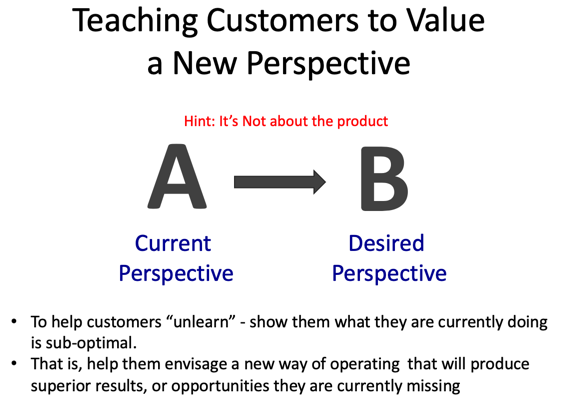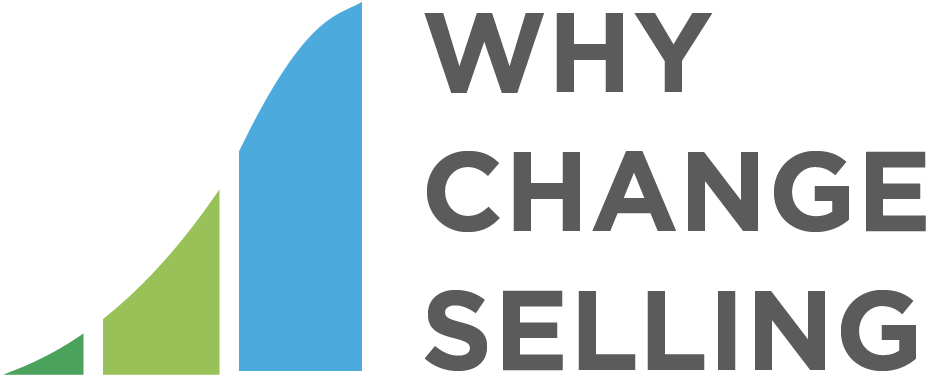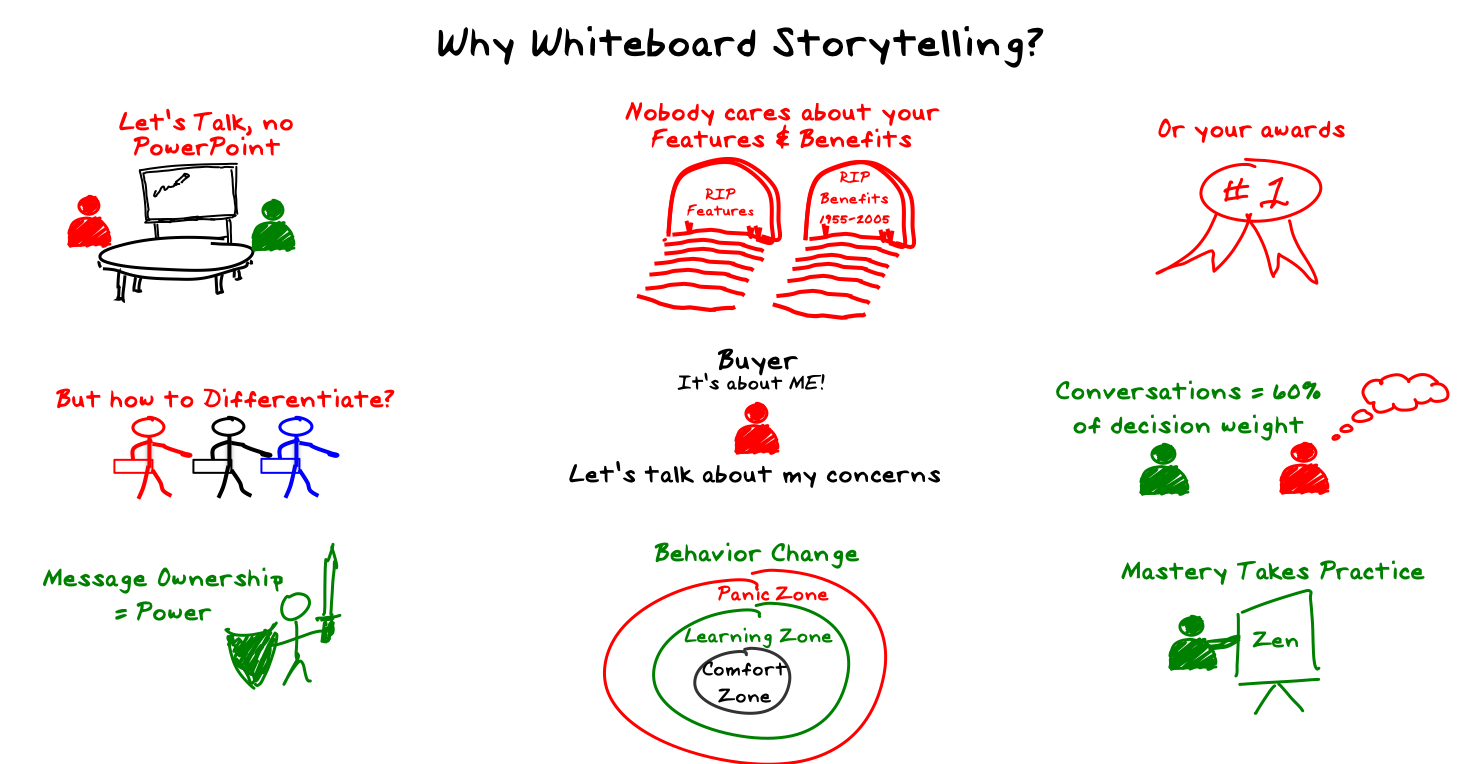People ask me this question when they are curious about creating whiteboards, and the truth is that it depends on your purpose and desired outcome. In this article, I discuss whiteboard types and their purpose and a process for creating a whiteboard story.
A hierarchy of whiteboard stories exists. At the top level, is the "solution" whiteboard. This is a story that sets out the company's unique vision and how it solves customer problems. The next level is a "product" story. This is quite specific and can be technical. It describes how using the products create customer value. At the lowest level is a "Vignette". The vignette describes how the product solves a specific problem.
Whiteboard Storytelling Purpose
Question: Do you expect salespeople to use the whiteboard story in front of customers, instead of relying on PowerPoint? Or, do you expect salespeople to learn and know the story, so that they gain confidence and can use elements of it contemporaneously in conversation?
If you answered yes to both you are correct. Situational fluency is our purpose in creating a whiteboard story. Our goal is to foster message-ownership so that salespeople, SE's and marketers are comfortable engaging buyers in conversations vs. presenting early in the buying process. Salespeople can use a whiteboard, flip chart, A-3 paper or Visual Confections to tell elements of their story in the time available and let the customer do most of the talking. Visual confections are powerful in conveying visual stories when time is short. They are particularly useful for inside-sales teams when the buyer is remote.
Outcomes of "Why Change" Stories vs "Why Me" Stories.
The outcome of a "Why Change" story is a new perspective for the buyer. Typically used early in the buying cycle, "why change" stories are designed to disrupt status-quo thinking.
This is the A->B step, where A is the buyer's current perspective and B is a desired new perspective, i.e. "we must change".

"Why Me" stories are much more straight-forward and explain why your product or service is superior and brings unique value vs competitors. This can be the B-C step, when the buyer appreciates a new perspective. Or they can be used in "bake-offs" when the buyer already knows what they want and they must choose a vendor.
Our "Why Change" stories use the "Challenger Sale" storytelling model.
The Challenger Storytelling Model
STEP 1. Lead with a hypothesis of your customers need, backed by your experience and research. – get acknowledgement this is the case.
STEP 2. Reframe – introduce a new perspective, be bold! - connect challenges to a bigger problem/opportunity. (We want the customer saying, - “I never thought about it that way”, not agreement).
STEP 3. Rational Drowning – why our perspective is important. This step uses data, graphs and ROI on solving challenges to make the point.
STEP 4. Emotional Impact – tells a story of the consequences of not changing. That is, how painful similar companies found it by behaving the same way they do - i.e. the pain of the status quo. vs. the upside from changing.
STEP 5. A New Way - a point-by-point review of new capabilities they will need to capitalize on the opportunity. They have to buy into your vision, before they buy into your stuff. A customer “who we’ve helped” story is a perfect way to create buyer vision.
STEP 6. Your solution - this should be a simple as a statement like, “and that’s what we do”. It may include a summary of the value your solution creates.
Factors Affecting Whiteboard Story Cost
Commercial Insight for "Why Change" Stories
Messaging that conveys commercial insight is necessary in a "why-change" whiteboard story. Unfortunately it is scarce or non-existent in most companies. Commercial insight requires a dedicated team effort to develop a detailed understanding of how customers derive real value from using your products/services. Few companies have the appetite for creating it because it is intellectually challenging. The process of creating commercial insight is the largest contributor to cost in whiteboard creation. Many companies have value-messaging frameworks that marketing created and these can be used in the whiteboard story to ensure the language in the whiteboard is congruent with corporate standards.
"Who We've Helped" Stories
Most companies with customers have created .pdf case-studies about their customer's use of the product/service. Unfortunately in most of these stories, the product/service or company is the hero of the story, not the customer. In most cases we will have to recover the customer story by using the .pdf as the foundation and speaking directly with the customer or the account team to get the real story and this adds development cost.
The "who we've helped" story uses the "hero's journey" storytelling format and starts with the situation before they changed, i.e. the status-quo, the buyers emotions and the trigger event that made them want to explore solution options.
In every major acquisition where process change is involved, there are complications. These are myriad, including pressure from a lack of funding, competing ideas, technology favoritism, regulatory pressure, incompetent buyers causing frustration, etc.
The zenith in story arc of the hero's journey is the turning point. This is the lightbulb moment or ah-ha moment, when the buyer grasps your vision of a future state where their problems are solved, or as Nancy Duarte calls it a glimpse of their "future bliss".
The story concludes with the resolution. Change is complete, the organization has transformed and they are deriving the value promised in the solution and live happily ever after.
Solution Complexity
Solution complexity adds to cost as it can create a need for additional development and review cycles to ensure the technical team approves the final version of the story.
"Why-Me" Stories
These stories tend to be product/service stories and in most cases, the marketing team has messaging that can be readily used by the whiteboard creation team.
The best "why-me" stories will about how customers use the product or service to create value and will have a "who-we've-helped" story for a similar buyer/industry embedded in their structure. When customer win-stories are in the form of corporate chest-pounding as described above, they will have to be redeveloped and can add cost.
The costs being charged by various companies creating whiteboard stories range from $20,000 for a basic whiteboard story, to $85,000 where a full messaging development process is a prerequisite for creating the why-change story story.




